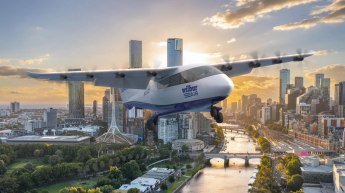
The new Cessna Citation Longitude is Wichita-based Textron Aviation’s latest entry into the ‘super mid-sized’ business jet market.
The Longitude, being a next generation Citation X minus the blistering speed and fuel bills, is the slightly larger big brother to the also new Cessna Citation Latitude, which itself is an upscaled version of the Citation Sovereign. Clearly looking to cover all demand in the mid-sized market, Cessna is also developing the larger Citation Hemisphere due in 2019.
The first impression is the sleek design from the dignified radome, which also houses the avionics compartment, then flowing out along the variable sweep, super-critical wings to the blended winglets. The elongated fuselage which utilises the area rule to minimise wave drag in the transonic range, is proudly topped off with a T-tail empennage.

With a range of 3,500nm and full-fuel payload of 726kg, this jet will comfortably take eight executives from Sydney to Perth at M0.82 whilst cruising above the airliners and weather at FL430. The predictive cabin pressurisation system functions at a non-perceptible rate regardless of intermediate level offs from ATC. And it will do FL450 with a cabin altitude around 5,900ft for greater passenger comfort. All the while, the two Honeywell HTF7700L turbofans, capable of pushing out 7,550lb, will only be burning 1,600lb/hr so the owner will enjoy lower fuel costs. It has one of the quietest cabins available, and crew must be mindful of their banter with passengers aboard.
The interior is carefully designed with a minimalist approach to keep everything decluttered, functional and stylish. If anything aboard exemplifies this the most, it is the overhead panel, typically populated with a superabundance of switches, knobs, buttons and c/bs, the Longitudes overhead panel is well… blank, with just a handful of light switches and a satphone.

The lack of traditional switches was realised in two ways. Firstly, non-critical non-essential c/bs were all moved to the baggage compartment, so the cockpit has just two simple thermal c/b panels on the left and right side. Most impressively though is how the Garmin G5000 has swallowed everything else into four touchscreen displays. From full system diagnostics to electronic checklists to the FMS, these vehicle management controllers interface with the entire aircraft avionics system and are intuitive to use with word/picture app selection just like a smart phone. It uses a hybrid navigation system relying on GPS rather than IRSs, however IRSs are an optional extra. Also incorporating ADS-B in/out making this jet compliant within Australian airspace. The CPDLC button is fitted for but currently not with.
Cessna has avoided jumping head first into the fly-by-wire crowd, instead taking a sensible learn-as-we-go approach by only integrating it into the rudder, spoilers and brakes.
The Longitude comes standard with a synthetic vision system (SVS) but has taken a step further by having the TCAS displayed not only on the map display but also the PFD if SVS is selected – a very useful tool to increase situational awareness in busy terminal areas. A left-side only head-up display and enhanced vision system are optional extras.
The modern galley embraces this simple design approach so that on short domestic flights, self-serve is a viable option for passengers. With an off-the-shelf espresso machine, microwave and cold box there is little to go wrong here. If a cabin attendant is required, a jump seat is available that can be folded away.

The passenger cabin is again simplistic, spacious and elegant. Even though it can accommodate up to 12 passengers, eight would be ideal with the two zones of four individual club seats. And each club seat has two USB charging ports. There is one rear vacuum type lavatory, and a 112 cubic foot cargo area which is part of the pressurised section, so is fully accessible during flight.
Performance wise, this super mid-sized jet should perform admirably into the majority of Australia’s sealed runways, requiring just 4,900ft to take off at its maximum weight of 39,500lb, and 3,400ft to land (unfactored).

By utilising machined parts and proven avionics Cessna has kept the Longitude’s weight and cost significantly down without compromising the look and feel of what is a very modern, safe and efficient jet.
It has some strong contenders including the Gulfstream G280, Challenger 350 and Dassault 2000, however the Cessna Citation Longitude has set a new benchmark for minimalistic intelligent design.

The Minimalist – Cessna's Citation Longitude
You need to be a member to post comments. Become a member today!
Comments (4)
Comments are closed.















Wayne Johnston
says:I like it. It would jave made a great RAAF Navigation trainer “back in the day”!
Marc
says:Fuel load 725kg
Fuel burn 1600lb/ hr
That doesn’t read tight.
Have I missed something?
Pat
says:These kinds of articles should be appearing much more often in AA – and maintenance related articles for Engineers. For as long as I have been a subscriber it’s predominantly been a magazine for business people.
Great article.
Doug bell
says:There appears to be a lot of interest with bus aircraft in the 8 seat capacity, I would have thought with both distance and numbers, there would be some further development in the 12 to 16 seat capacity aircraft capable of 7- 9 hour sectors, especially in the South Eastern Asian/Pacific basin. Perhaps the economies of scale are not there, yet that style aircraft would also suit both American and Continental market space.